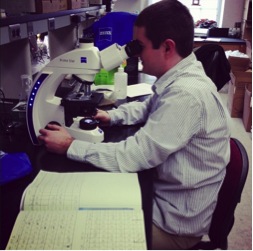This past semester, I have been working as an undergraduate intern in Dr. vanEngelsdorp’s honey bee lab at the University of Maryland. My previous bee knowledge consisted of only a few fun facts learned in intro biology courses and some honey extracting methods learned while working with another professor in the entomology department here at UMD. Needless to say, my expertise in honey bees has vastly grown. I could tell you the differences between a queen, drone, and worker bee and why they do a few of the many amazing things they do.
More specifically, I have been working on a Nosema spore project. Along with two other interns, I have been preparing and examining bee samples for Nosema spores. We each made a sample of 30 and 100 bees (crushed and mixed with 1 mL water for each bee) and then shared our own samples with each other so that every sample was tested three times. The main goal of the project is to test sampling methods; as in would we find different results from a smaller or larger sample set of bees, or how often a sample would be an outlier from the actual average for that batch.
 At first, sampling would take me nearly my entire three-hour-per-week session to complete. I had used microscopes and all of the other tools used in the lab in previous biology classes, but that was back in freshman year and I was a little rusty. Luckily, everyone in the lab was extremely nice and helpful whenever I had a question. A few short months later, and I can complete the same amount of sampling in half the time. My experience in the lab was a great one and I am really glad I was able to learn a little more about the amazing honey bee.
At first, sampling would take me nearly my entire three-hour-per-week session to complete. I had used microscopes and all of the other tools used in the lab in previous biology classes, but that was back in freshman year and I was a little rusty. Luckily, everyone in the lab was extremely nice and helpful whenever I had a question. A few short months later, and I can complete the same amount of sampling in half the time. My experience in the lab was a great one and I am really glad I was able to learn a little more about the amazing honey bee.
This post was written by Kyle Runion, an undergraduate intern in our lab.
